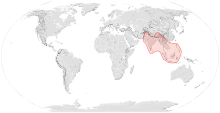Apis dorsata
| Giant honey bee | |
|---|---|
 |
|
| On Mimosa pudica | |
| Scientific classification | |
| Kingdom: | Animalia |
| Phylum: | Arthropoda |
| Class: | Insecta |
| Order: | Hymenoptera |
| Family: | Apidae |
| Genus: | Apis |
| Subgenus: | (Megapis) |
| Species: | A. dorsata |
| Binomial name | |
|
Apis dorsata Fabricius, 1793 |
|
 |
|
| Range of A. dorsata | |
Apis dorsata, the giant honey bee, is a honey bee of South and Southeast Asia, found mainly in forested areas such as the Terai of Nepal and sometimes even in Malaysia and Singapore. They are typically around 17–20 mm (0.7–0.8 in) long. Nests are mainly built in exposed places far off the ground, like on tree limbs, under cliff overhangs, and sometimes on buildings. These social bees are known for their aggressive defense strategies and vicious behavior when disturbed. Indigenous peoples have traditionally used this species as a source of honey and beeswax, a practice known as honey hunting.
Apis dorsata belongs to the family Apidae, which is in the class Insecta. This honeybee is most closely related to Apis mellifera, (the Western honey bee) Apis cerana, and Apis florea. Apis dorsata belongs to the subgenus Megapis. There are a few hypotheses as to when Apis dorsata diverged from both Apis florea and Apis cerana, as it is unclear which divergence occurred first. Currently, the consensus hypothesis provides a family tree that claims that Apis dorsata diverged from both Apis cerana and Apis florea at the same time.
Michael S. Engel identified the following subspecies:
A. d. laboriosa is not distinct morphologically from the nominate subspecies but has different housekeeping and swarming behavior, allowing it to survive at high altitudes. In addition, little gene flow has occurred between A. dorsata and A. d. laboriosa for millions of years; accordingly, some argue it should be classified as a distinct species. Likewise, the southeastern taxon A. d. binghami seems also to be distinct. The limits of their ranges in Indochina and the possible distinctness of the geographically distant Philippines population require more study. However, the use of the taxonomic rank of "subspecies" is typical for geographically discrete populations, so the difference in opinion here is whether or not to recognize the rank of subspecies or not (i.e., no one is disputing they are distinct lineages, the dispute is over whether to call them "species").
...
Wikipedia
